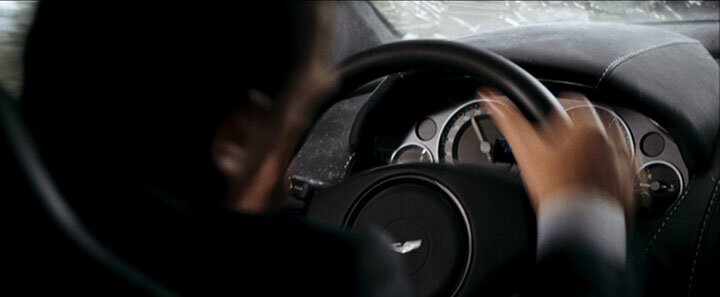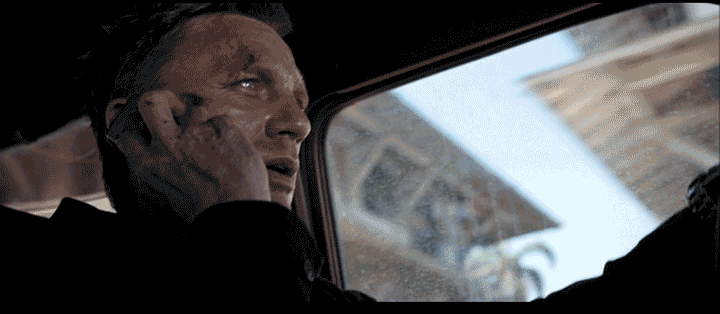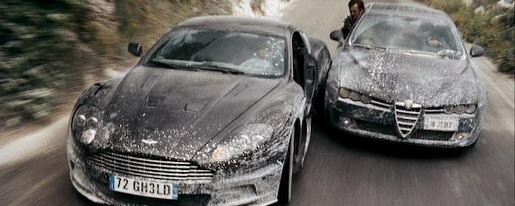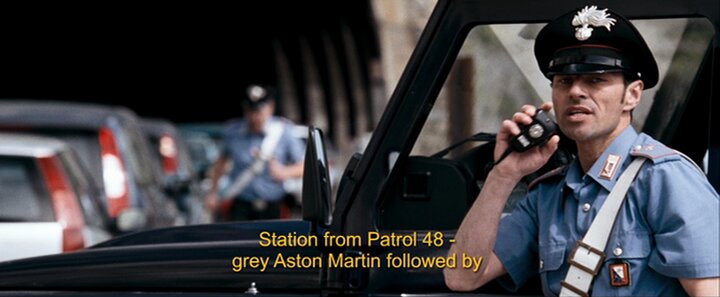Login
| Skyfall Week: BlogalongaBond: Quantum of Solace (2008) |

|

|
| Written by Ivan Radford |
| Thursday, 25 October 2012 20:20 |
|
BlogalongaBond. One Bond film a month until Skyfall comes out tomorrow. (OH MY GOD SKYFALL IS OUT TOMORROW! AT LONG LAST. ALL THAT ROGER MOORE WAS WORTH IT.) It wasn't without excitement that I went into Quantum of Solace. After Martin Campbell's brilliant Casino Royale, Bond's return was a cinematic event worth salivating over. Even the choice of Marc Forster seemed promising - an arthouse director helming a blockbuster? What a grand idea! But while Daniel Craig's craggy, emotional 007 remained a captivating hero - more a landmine than a lead actor - everything else was kind of, well, dull. There are good bits, let's be clear on that. The environmentally-aware Bond villain (an amusingly whiney Mathieu Amalric) and double-crossing CIA plans are proper shades of grey stuff, but while the set-up is promising, Quantum forgets to add a plot. Was it the writers' strike that left them without the time to finish writing the film? Whatever the reason, the end result was a Bond movie with 25% of a script and 75% white noise. So they did what any blockbuster would and filled it with action. That wouldn't be a problem if it was good action. But it isn't. Like Yakult, there are good types of action and bad types of action - and this is the bad type. The kind you wouldn't want anywhere near your body, just in case it blew up sideways and chopped your face off. And that really is how you feel for most of the runtime. The opening begins with a glorious tracking shot over an Italian lake, carefully intercut with shots of Bond’s Aston Martin. But once that shot is finished, the footage is over-edited to shreds. With the exception of one crosscutting night at the opera, the set pieces are so kinetic that you can't tell what's happening; a tin of tuna could direct a better action sequence. At least it would be stationary. At one point during that opening car chase, it looks like Bond drives off a cliff and explodes to death. When Bond finally stops and says it’s time to get out to his shaken and stirred passenger, he’s not the only one ready to leave. It wasn't without excitement that I went into Quantum of Solace. It was with confusion that I left. So what went wrong? Two things: Matt Chesse and Richard Pearson. How did the editors screw up so badly? They probably read this informative pamphlet I found in my DVD box... How to Edit a James Bond FilmSo, you’ve just been hired to edit a Bond film, eh? Congratulations! There are just a few simple lessons you need to learn to earn your license to thrill (ha, you can have that one for free, if you like). 1. Jump cut, jump cut!
“Jump up! Jump up!” sing the band when Sean Connery strolls into Puss Feller’s bar in Dr. No, but they might as well have been singing “Jump cut!” While Dr. No saw Connery define Bond’s schwagger and schpeech patterns, another guy stepped in and defined something else even more important: Bond’s style. That guy? Editor Peter Hunt. From almost the very first scene in the first very first Bond film, Hunt introduced the idea of the jump cut with the death of Strangeway’s secretary at the hands of the Three Blind Mice: a quick cut that saw her go from screaming to shot in half a blink of an eye. The habit stuck. From Russia with Love’s train fight with Red Grant was full of tiny jumps, making the audience feel every single punch from Red. People talk about Jason Bourne’s hyperactive style, but Hunt started this stuff first. If you want to keep things raw and gritty, do what he did. Jump cut, baby. 2. Chop to the chaseBond gets up. He scratches his arse. He looks around for the socks from the night before that he removed in the heat of passion. He goes to the bathroom, squirts some toothpaste into his eye, pees, wipes down the toilet seat, washes his hands and goes back into the bedroom to finish dressing. Bored yet? Nobody likes seeing everything in long hand, so cut to the chase. Hunt helped to introduce that one to action films too. “If you looked at any films made before 1961, even American films, they always have the guy walking down the steps, through the gates, getting into the car and driving away,” Hunt explained in an interview. "We don't do any of that anymore! The fellow says he's going, and he's there. “ 3. Be creative
Changing colours, back projection, switching locations, editing is all about playing with images. Need to convey some high tech data? Flash it up on the screen. Missing a key shot in a sequence, like Strangeways walking towards a house in the evening during Dr. No? Take your existing footage of Bond walking there in the daytime, flip it over, suck out the exposure and just use that instead. Problem solved - a good spot from ShatterHand007. Sure, you could just leave the shot out altogether, but then you’d end up with something disjointed. And who wants that in a Bond film? 4. Shoot moving targetsNo one likes stationary objects – those are boring. If you want to make an action film, you’ll have to shoot moving targets. They’re obviously harder to film, but don’t let that stop you. You could even move the camera with the characters. You may not think it, but tracking shots are classic Bond. You Only Live Twice had an epic sequence where Bond is running around at Kobe harbour. 007 explodes up onto the roof, only for director Lewis Gilbert to do the same, whooshing over the top in a helicopter and flying along the building as Connery takes on a horde of henchman.
Of course, you don’t have to use a helicopter. You could track with Bond’s car, you could follow him down a tunnel, you could even dive after him through a glass roof into an art gallery in the middle of a punch-up. Just make sure you have an establishing shot to cut to before hand – things might get messy if not. 5. Get in close
Close-ups are good for those intense, violent fight scenes. Take a look at the start of On Her Majesty’s Secret Service: throughout the scrap on the beach, Peter Hunt keeps cutting to Bond’s hands and arms half underwater. Of course, by this point Hunt has graduated from the position of editor to director. He makes sure his visual legacy continues, though, by hiring an upcoming talent to edit OHMSS and direct the second unit: John Glen. (12 years later and Glen became a director too. No wonder Bond’s editors have been so influential in the evolution of 007’s style; they keep getting promoted.) 6. Have a hands-on approach
Handheld cameras aren’t just for home movies. Years before Steven Spielberg’s Saving Private Ryan, Peter Hunt was at it again in On Her Majesty’s Secret Service. Sellotaping the camera to a pair of skis – well, to Willy Bogner, Jr. – Hunt pushes his cameraman backwards down the slope and watches him go. It’s as shaky as shakycam gets, but by heck, it’s exhilarating. Why? Because Hunt, Bogner and Glen are smart enough to cut away to long shots of the slopes every minute. It’s exactly the same trick they use throughout the film when Bond has one-on-one fisticuffs with a henchman: wobbly frames, but long takes. The handheld camera even drops to the floor when Bond does. The moral of the story? Shakycam works, but only in moderation. 7. Get in the passenger seat
This is something we learned years ago: car chases are fun, but only if we get to see the people driving the cars. If not, it’s just large-scale Scalextric. Cut inside the car as often as you can. Gear changes, sudden turns, handbrakes – show the audience how much effort it takes to do these stunts. Things are more impressive and exciting that way. Just cross your fingers that your two vehicles don’t look too similar. If not, your establishing shots are screwed and no one will have a clue what’s going on.
Hell, if that happens, you might even have to use dialogue and subtitles to explain what should be a visual sequence…
8. Keep things moving quickly
Bond movies are not meant to be slow. Ever wondered how Peter Hunt went from editor to director? He was called in to re-edit You Only Live Twice after Thelma Connell's original three-hour cut was slammed by Eon. So the solution is simple: make sure everything is fast. Of course, “fast” is a relative term. Hunt’s catchy jump-cutting work on Dr. No gives the film an average shot length of 6.6 seconds (according to cinemetrics.lv). By the time Casino Royale rolls around, what’s considered fast in the industry is a zippy 2.9 seconds. The Bourne Supremacy is even choppier, clocking with an average shot length of 2.4 seconds. Still, don’t be afraid to try and match that. You can even bring in one of the Bourne series' editors to help out, if you like.
And there you have it. Follow those steps and you’ve got yourself a perfectly edited Bond film. Jump cuts, crash cuts, close-ups, handhelds, tracking shots, inside-vehicle shots and fast edits. If you can put that all together in a new way that will really have an impact upon audiences, people will remember you forever. So what went wrong? Chesse and Pearson took it too far.
The overlaid tech stuff? Brilliant. The locations' establishing shots? Stunning. Everything else you could barely see. Inevitably, given Pearson's back catalogue, The Bourne Ultimatum was the film everyone compared Quantum of Solace with. Paul Greengrass’ finale for the Bourne trilogy had an average shot length of just 2.2 seconds. Quantum of Solace? 2 seconds flat. “One of the things you contribute as an editor is that you bring a naïveté to a lot of those decisions,” Chesse told Editor Under Construction in 2010 while discussing his career. “Even a shot that they took a long time planning, you see it with different eyes. Like some huge crane shot, they´d spend the money, they´d bring it over and it´d be such a great piece of choreography it´s, like, oh, man, we´ve got to use that whole establishing shot; that is so great. And I´ll be sitting there cutting with none of those notions; I just want to cut from that scene into something else, and I might not need an establishing shot. And I´ll just dispose of that kind of stuff because it didn´t cost me anything; so I can dismiss it.” He then added of long-time collaborator Marc Forster: “After it´s shot, Marc´s not one who likes to do the tinkering or hover over you and go through every inch of footage. He´s very trusting, not only of me but with all of his professionals; he lets them create to their fullest.” It’s all very well doing that on Finding Neverland or Monster’s Ball. But on a Bond film, where cars are flying off cliffs and people are jumping off buildings? Maybe some strict supervision could’ve helped. The Frasier quote springs to mind, not for the first time in Bond’s history: “If less is more – imagine how much more more is.” Three words for that attitude: cut it out.
BlogalongaBond will return next month in Skyfall - review this way. For more BlogalongaBond goodness, go over here.
Tags:
|




